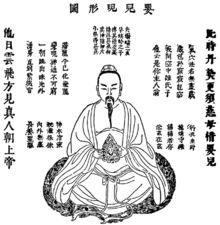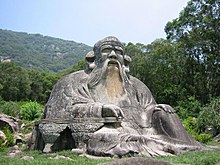Taoism
![]()
This article or subsequent section is not sufficiently supported by evidence (e.g., anecdotal evidence). Information without sufficient evidence may be removed in the near future. Please help Wikipedia by researching the information and adding good supporting evidence.
Daoism (Chinese 道家, Pinyin dàojiā - "teaching of the way"), according to other transcriptions also Taoism, is a Chinese philosophy and worldview and is considered China's own and authentic religion. Its historically verified origins lie in the 4th century BC, when the Daodejing (in older transcriptions Tao te king, Tao te ching and the like) of Laozi (Lao-tzu) was written. There are sometimes important differences between philosophical and religious Daoism, but ultimately the two cannot be sharply distinguished from each other.
Along with Confucianism and Buddhism, Daoism is one of the Three Doctrines (三教, sānjiào) that has had a significant influence on China. Even beyond China, the Three Teachings have exerted significant influence on religion and the spiritual world of the people. In China, Daoism influenced culture in the areas of politics, economics, philosophy, literature, art, music, nutrition, medicine, chemistry, martial arts, and geography.

Dào

Daoist Adept
Origin
Exactly when the Daoist doctrine came into being remains unclear. Daoism has only taken shape in a long development process, whereby currents of antiquity were continuously integrated. With the Daoist doctrine, much thought is taken up that was widespread in China at the time of the Zhou dynasty (1040-256 BC). This includes the cosmological ideas of heaven and earth, the five phases of transformation, the doctrine of Qì (energy), Yin and Yang and the Yijing (I Ching), but also the tradition of body and mind cultivation, by means of which immortality was to be achieved with breath control and other techniques such as Taijiquan and Qigong, meditation, visualization and imagination, alchemy and magical techniques. The quest for immortality, a central theme of Daoism, probably goes back to very ancient beliefs, for the Zhuangzi, a Daoist classic from the 4th century BC, already mentions the Xian, the immortals, the most important of whom are the Yellow Emperor, Huangdi, and the Queen Mother of the West, Xiwangmu. These are figures who may have existed as early as the Shang period in the 2nd millennium BC.
Distribution
Due to the various forms of expression, the unclear demarcation from other religions and the lack of statistical recording in the People's Republic of China, the exact number of followers of Daoism is difficult to record. About 8 million Daoists live today on Taiwan, where many followers of Daoist schools sought refuge from the persecution of the Cultural Revolution.
The Daoist Association in the People's Republic estimates that there are approximately 60 million Daoist believers in the PRC. Daoism is also widespread among overseas Chinese and in other Asian countries such as Malaysia, Singapore, Vietnam, Japan and Korea.
Laozi and the Daodejing
Whether there really was a thinker named Laozi (Chinese 老子 - "the old master") is doubted today. Traditionally, the Daodejing (the classic of the Dao and the De) is attributed to him. His biography is shrouded in legend and extremely controversial. He is said to have lived during the time of the Spring and Autumn Annals in the 6th century BC, which was marked by unrest and war. It represents a heyday of Chinese philosophy, as many scholars were thinking about how peace and stability could be achieved again. Therefore, it is also called the time of the Hundred Schools. The Daodejing contains such a teaching, which is directed at the ruler and wants to bring about peace.
The Daodejing is also called Laozi by the name of its legendary author. In its present form it is divided into two books with a total of 81 chapters. The first part deals with the Dao, the second with the De. However, the book does not represent a logically structured construction of a world view, but rather appears as a disorderly collection of mystical aphorisms that inspire one's own subjective interpretation. Therefore, in the course of time, several hundred commentaries were written as interpretations of the text, as well as hundreds of translations.
The Zhuangzi
→ Main article: Zhuangzi
In contrast, the Nanhua zhen jing, "The True Book of the Southern Flowerland" (actually "The True Book from Nanhua", the city from which Zhuangzi came, who was also called "the true man from Nanhua"), is written quite differently. It was written in the 4th century BC, shortly after the Daodejing was written, by Zhuangzi (Chuang Dsi, Chuang-tzu, c. 369-286 BC), after whom it is also called Zhuangzi (also Chuang Dsi). In it, the essence of Daoism is explained in often paradoxical parables and anecdotes, into which philosophical discussions are woven. Zhuangzi takes up some of the ideas of the Daodejing, but rejects others - for example, there is nothing left of Laozi's political aims. The world-averse sage (Zhenren) is the ideal image here. As with the Daodejing, the authorship is disputed. Although Zhuangzi is certainly a historical figure, the book was probably compiled in large part by his students.
The Liezi
The Liezi (also Lieh-tzu or Liä Dsi), or the "True Book of the Springing Primordial Ground," resembles the Zhuangzi in some sections. The wisdom, often presented in a humorous manner, was compiled, some scholars suggest, over a period of about six hundred years (300 BC to 300 AD). Others see Liezi as a historical figure who lived before Zhuangzi, or assign the book to a philosophical school. The book includes the teachings of the philosophers Liä Yü Kou and Yang Dschu, although Richard Wilhelm points out that there is no historical evidence for the former. The "Revelations of the Invisible World" given in the first book show the profound Daoist engagement with philosophical questions, for example when in the fourth section a saying of the Lord of the Yellow Earth is quoted: "The spirit goes in to its gates, the body returns home to its root, how can the I last there?", or in the seventh and eighth sections two quotations attributed to Confucius (in the text: Dschung Ni), or to the "Master Yän", are given, in which it is said, mutatis mutandis: "Great is death: the good it brings to rest, the bad it subdues."
At the time of Laozi and Zhuangzi, there is no evidence of a philosophical or religious organization that could be called Daoism. There are only isolated texts that bear witness to Daoist thought and that were later regarded as canonical writings when Daoist organizations were founded. However, it is undisputed that these texts were developed in connection with religious practices and beliefs.

Laozi, larger-than-life stone figure from the Song Dynasty near Quanzhou
Daoism between philosophy and religion
The distinction between Daoism as a religion and Daoism as a philosophy, long used by sinology, is conceptually fuzzy. It is more of a tool of Western sinology and was introduced to make it easier to describe different aspects of the long history of Daoism. Nevertheless, Chinese also distinguishes between philosophical Daoism (Daojia, 道家, dào jiā) and religious Daoism (Daojiao, 道教, dào jiào). Daoism, however, is as multifaceted a phenomenon as other religions. In the course of its more than two thousand years of history, a wide variety of doctrines and systems have been developed. Today's sinologists see in religious Daoism the practical realization of philosophical Daoism. The separation of religious and philosophical Daoism is therefore a simplification; in research there are therefore tendencies not to use this distinction any more, because it does not do justice to the complexity of the subject. The pair of terms is at least of limited use, because it allows for a first, helpful outline in a description of Daoism. However, the subject matter is much more complex than this simplification suggests.
Questions and Answers
Q: What is Taoism?
A: Taoism or Daoism is a type of belief, or a way of thinking about life that originated in China at least 2,500 years ago.
Q: What is Tao?
A: Tao (or Dao, 道) is the name of the force or the "Way" that Taoists believe makes everything in the world.
Q: How do Taoists describe Tao?
A: Taoists think that words cannot be used to correctly describe Tao. The very first line of the Dào Dé Jīng (道德经), the most important text in Taoism, says "the Way that can be explained in words is not the true Way."
Q: What is one of the most important principles in Taoism?
A: One of the most important principles in Taoism is to focus on living a simple and balanced life in harmony with nature.
Q: What do Taoists believe about conflict?
A: Taoists believe that conflict is not good and that if you have a problem with something, it is better to find a way around it.
Q: Is Taoism a religion or a philosophy?
A: Taoism is now said to be a philosophy.
Q: Are there other sacred writings in Taoism besides the Dào Dé Jīng?
A: Yes, there are many other sacred writings by the teachers of Taoism.
Search within the encyclopedia